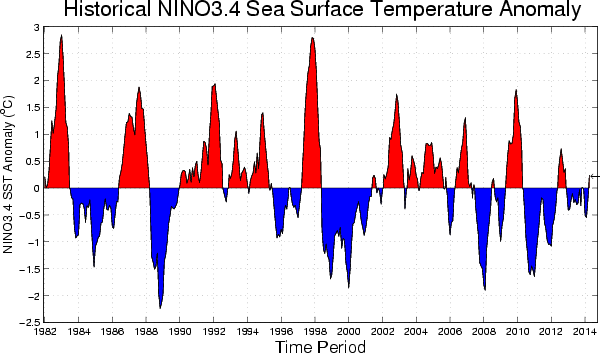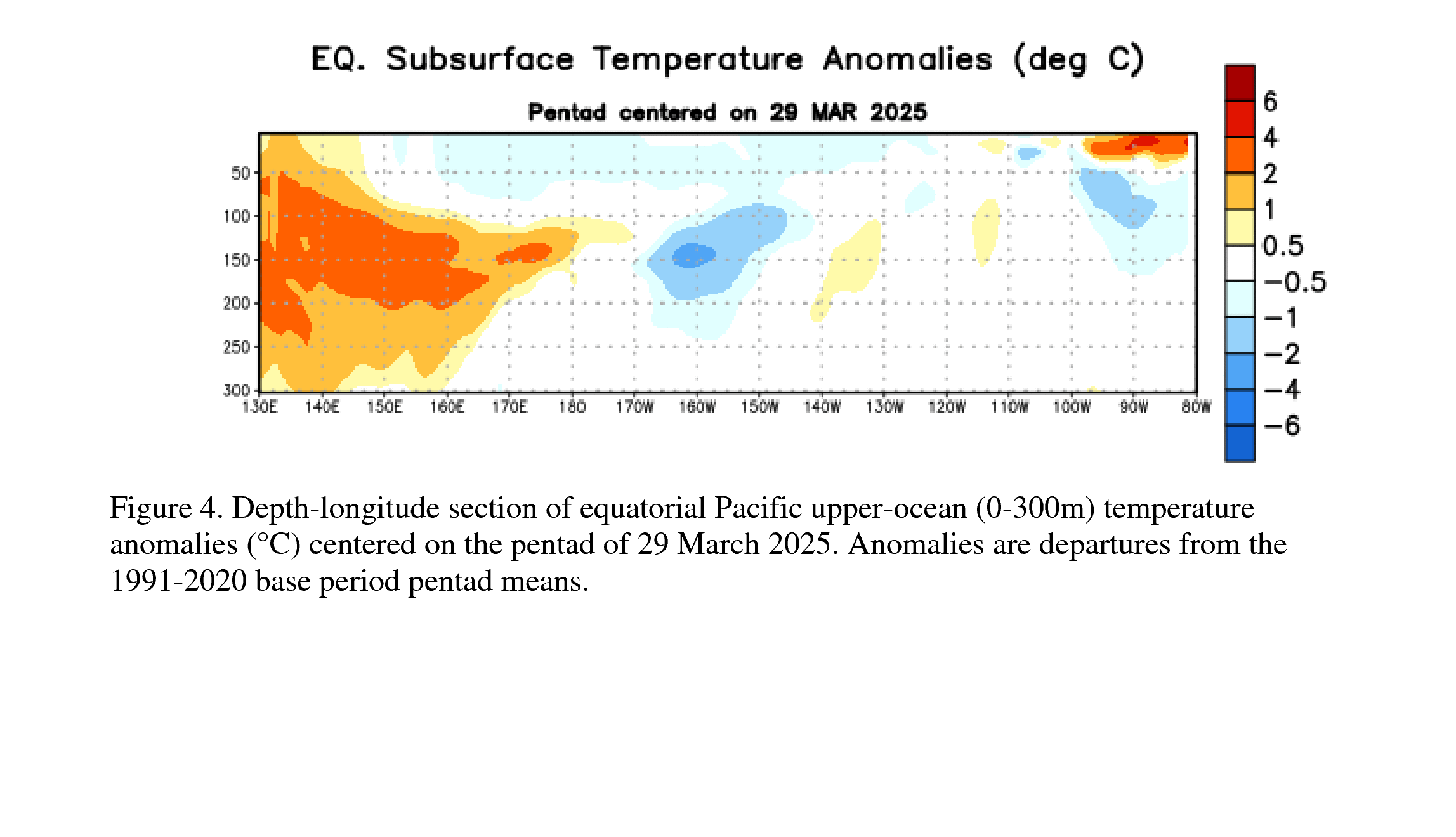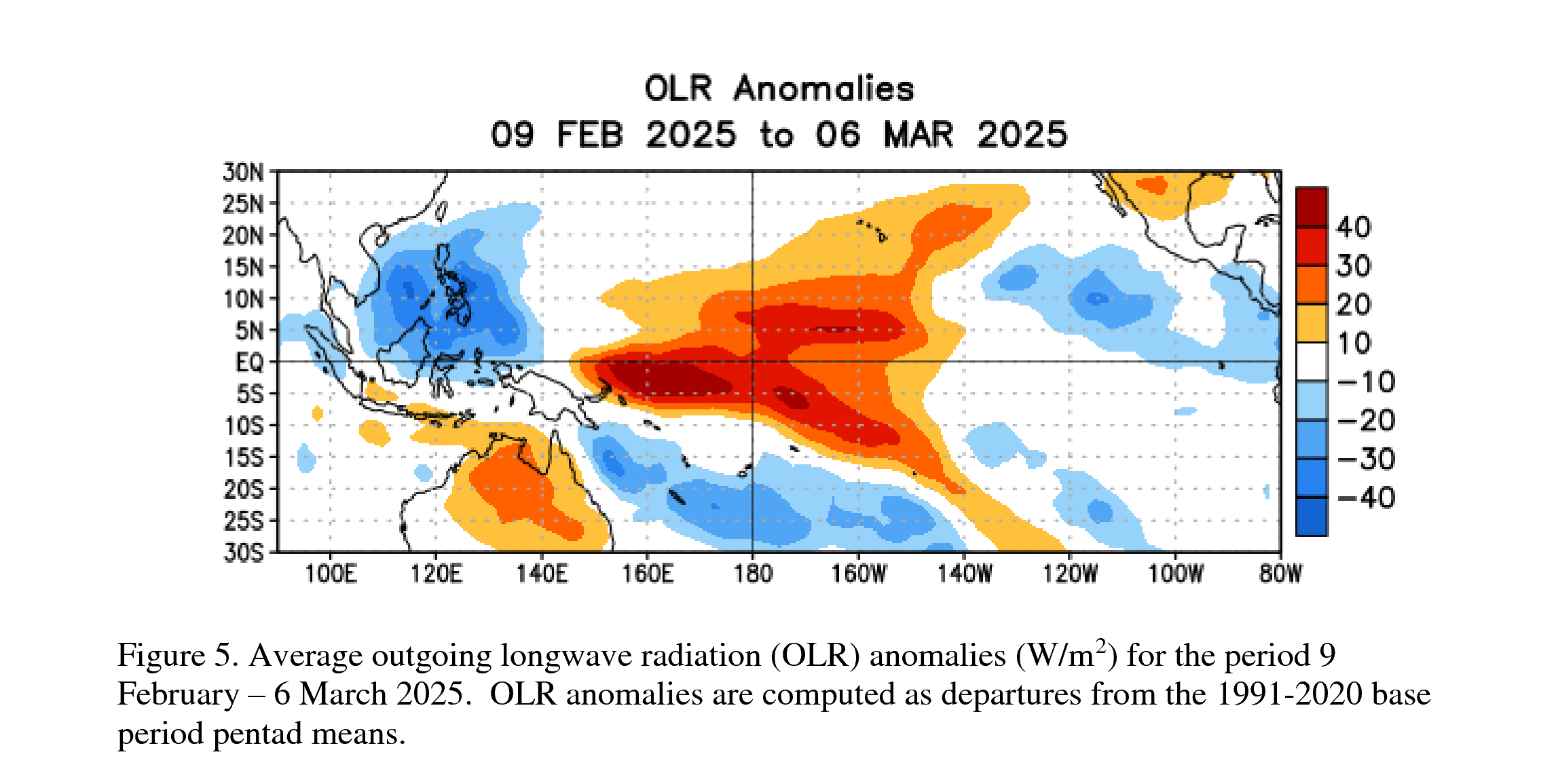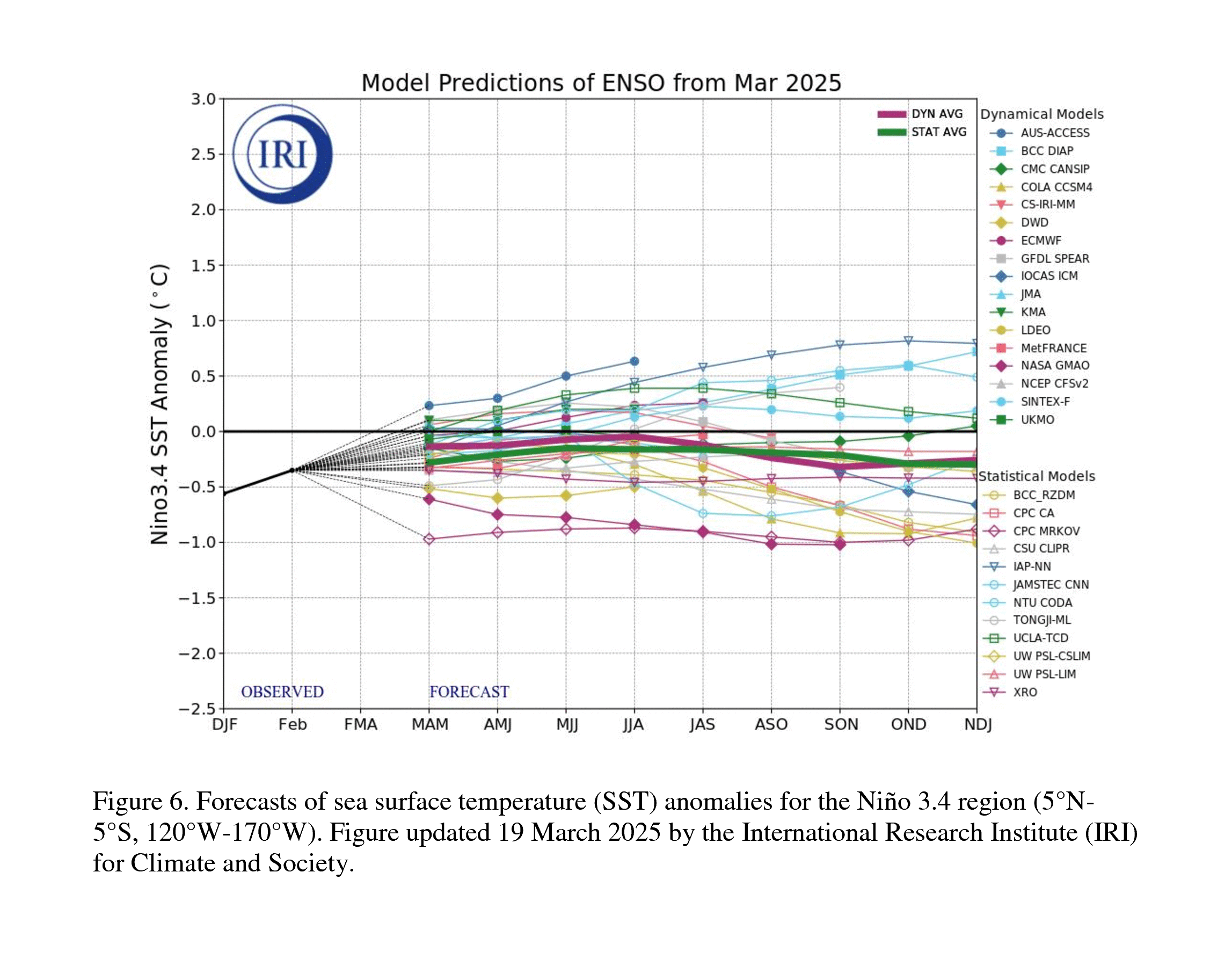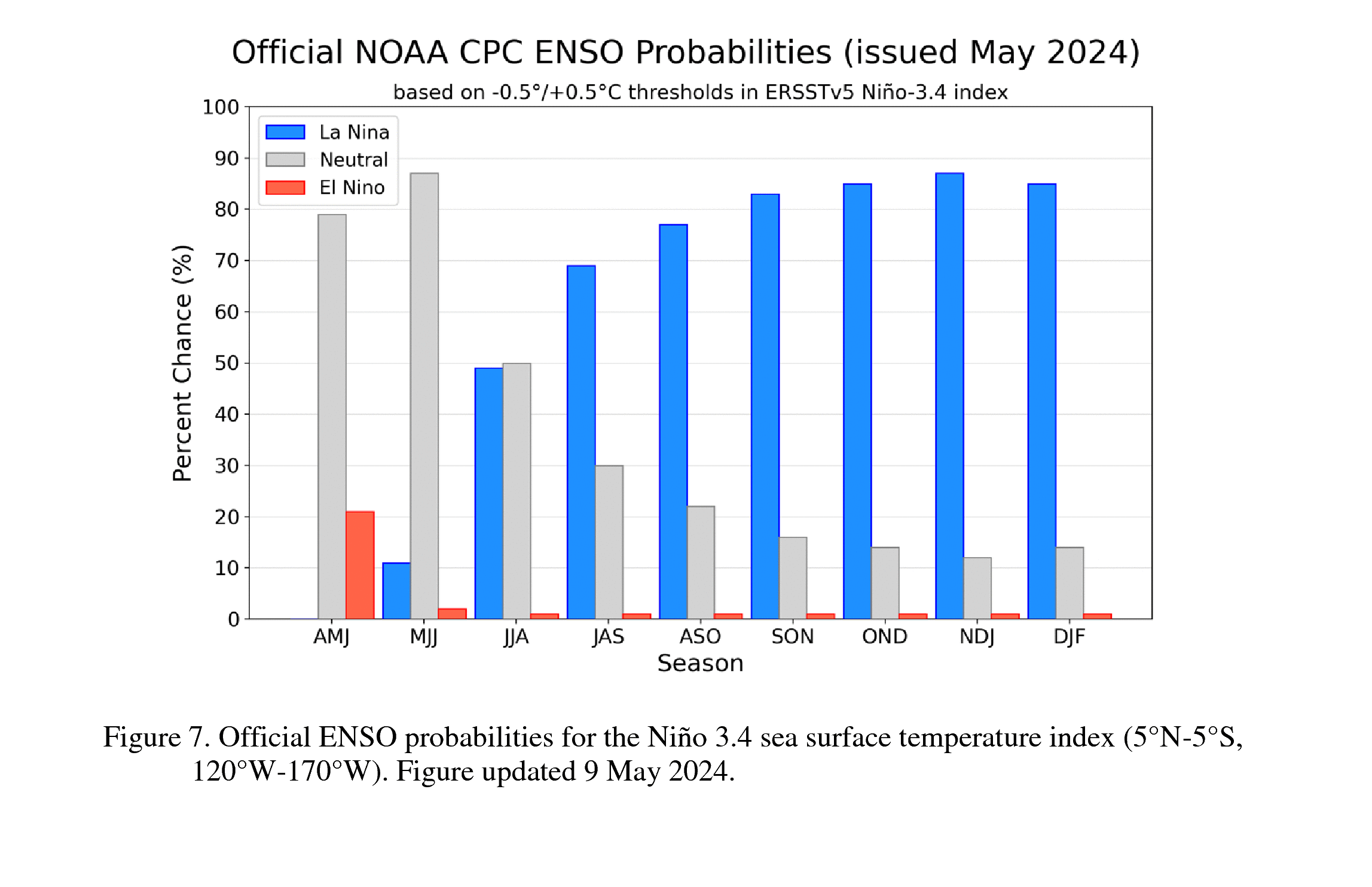IRI ENSO Forecast
IRI Technical ENSO Update
Published: May 15, 2014
Recent and Current Conditions
The SST anomaly in the Nino3.4 region in recent weeks has been in the neutral range but rising during the mid-April to mid-May period, 2014. For April the Nino3.4 SST anomaly was 0.24 C, indicative of neutral conditions, and for Feb-Apr it was -0.18 C. The IRI’s definition of El Niño, like NOAA/Climate Prediction Center’s, requires that the SST anomaly in the Nino3.4 region (5S-5N; 170W-120W) exceed 0.5 C. Similarly, for La Niña, the anomaly must be -0.5 C or less. The climatological probabilities for La Niña, neutral, and El Niño conditions vary seasonally, and are shown in a table at the bottom of this page for each 3-month season. The most recent weekly SST anomaly in the Nino3.4 region was 0.5 C, which is warmer than the 0.24 C observed in March, and is at the borderline of an El Niño condition if it were to persist. The trend is then an upward one both for Feb-Apr to April, and from April to last week’s observation.
Expected Conditions
What is the outlook for the ENSO status going forward? The most recent official diagnosis and outlook was issued earlier this month in the NOAA/Climate Prediction Center ENSO Diagnostic Discussion, produced jointly by CPC and IRI; it called for a likelihood for neutral ENSO conditions continuing into part of the remainder of spring 2014, but with probabilities of El Niño rising to 67% by Jun-Aug 2014, and to 78% by northern autumn 2014. The latest set of model ENSO predictions, from mid-May, now available in the IRI/CPC ENSO prediction plume, is discussed below. Currently, Nino3.4 SST anomalies are at the borderline of neutral and weak El Niño. Positive anomalies are marked near the dateline and also in the far eastern part of the Pacific basin. Subsurface temperature anomalies across the eastern equatorial Pacific are well above average levels, due to a downwelling Kelvin wave triggered by two westerly wind events in the western tropical Pacific during the Jan-Mar period. These anomalies at depth have been surfacing in the far eastern part of the basin. In the atmosphere, the basin-wide sea level pressure pattern (e.g. the SOI) has been close to average recently. The low-level zonal winds have shown westerly anomalies in portions of the basin, such as somewhat east of the dateline during late April/early May, while the upper level winds have shown easterly anomalies over some longitude bands. Anomalous convection (as measured by OLR) has been positive near the dateline, and just slightly positive in some portions of the basin east of the dateline. Together, these features continue to reflect ENSO conditions near the borderline of neutral and weak El Niño. The hints toward some ocean-atmosphere coupling (westerly wind anomalies and positive SST anomalies in the central equatorial Pacific) could induce larger anomalies in both ocean and low-level atmosphere that could lead to increased coupling as the onset of El Niño conditions likely gets underway over the course of the coming month or two.
As of mid-April, none of the dynamical or statistical models models predicts La Niña SST conditions for the May-Jul 2014 season, 56% predicts El Niño conditions, and 44% indicates neutral ENSO. At lead times of 3 or more months into the future, statistical and dynamical models that incorporate information about the ocean’s observed subsurface thermal structure generally exhibit higher predictive skill than those that do not. For the Aug-Oct 2014 season, among models that do use subsurface temperature information, none predicts ENSO-neutral SSTs, 100% predicts El Niño conditions and none predicts La Niña conditions. For all model types, the probability for neutral ENSO conditions is below 50% for all forecast periods, and is highest (near 40%) for May-Jul 2014 (very beginning of period) and Jan-Mar 2015 (very end of period). Probabilities for El Niño rise to 72% for Jun-Aug and Jul-Sep 2014, and as high as 87% for Sep-Nov, falling to about 60% by Jan-Mar 2015. No model predicts La Niña conditions for any of the 3-month periods between May-Jul and Jan-Mar 2015.
Note – Only models that produce a new ENSO prediction every month are included in the above statement.
Caution is advised in interpreting the distribution of model predictions as the actual probabilities. At longer leads, the skill of the models degrades, and skill uncertainty must be convolved with the uncertainties from initial conditions and differing model physics, leading to more climatological probabilities in the long-lead ENSO Outlook than might be suggested by the suite of models. Furthermore, the expected skill of one model versus another has not been established using uniform validation procedures, which may cause a difference in the true probability distribution from that taken verbatim from the raw model predictions.
An alternative way to assess the probabilities of the three possible ENSO conditions is more quantitatively precise and less vulnerable to sampling errors than the categorical tallying method used above. This alternative method uses the mean of the predictions of all models on the plume, equally weighted, and constructs a standard error function centered on that mean. The standard error is Gaussian in shape, and has its width determined by an estimate of overall expected model skill for the season of the year and the lead time. Higher skill results in a relatively narrower error distribution, while low skill results in an error distribution with width approaching that of the historical observed distribution. This method shows probabilities for La Niña no higher than 2% for any period between May-Jul 2014 through Jan-Mar 2015. Model probabilities for neutral ENSO conditions are near 50% for the initial period of May-Jul 2014, near 40% for the next running period of Jun-Aug, and the hover near 30% through the northern summer and fall 2014, rising again to near 35% for Dec-Feb 2013-14 and just over 40% for Jan-Mar 2015. Probabilities for El Niño are just above 50% for May-Jul 2014, rise to near 60% for Jun-Aug, nearly 65% for Jul-Sep, and rise to near 70% for Sep-Nov, Oct-Dec and Nov-Jan 2014-15. It is clear that the models collectively favor El Niño over other ENSO conditions between Jun-Aug 2014 and Dec-Feb 2014-15. A plot of the probabilities generated from this most recent IRI/CPC ENSO prediction plume using the multi-model mean and the Gaussian standard error method summarizes the model consensus out to about 10 months into the future. The same cautions mentioned above for the distributional count of model predictions apply to this Gaussian standard error method of inferring probabilities, due to differing model biases and skills. In particular, this approach considers only the mean of the predictions, and not the total range across the models, nor the ensemble range within individual models.
The probabilities derived from the models on the IRI/CPC plume describe, on average, a transition from neutral ENSO conditions during late northern spring to a likely development of El Niño development during May-Jul 2014, as the objective model-based probabilities for El Niño exceed those for neutral ENSO by more than a small margin between Jun-Aug 2014 and Dec-Feb 2014-15. The consensus of model predictions calls for a weak to moderate El Niño event. A caution regarding this latest set of model-based ENSO plume predictions, is that factors such as known specific model biases and recent changes that the models may have missed will be taken into account in the next official outlook to be generated and issued in early October by CPC and IRI, which will include some human judgement in combination with the model guidance.
Climatological Probabilities
| Season |
La Niña |
Neutral |
El Niño |
| DJF |
37% |
28% |
35% |
| JFM |
34% |
37% |
29% |
| FMA |
30% |
48% |
22% |
| MAM |
26% |
54% |
20% |
| AMJ |
24% |
54% |
22% |
| MJJ |
25% |
51% |
24% |
| JJA |
25% |
50% |
25% |
| JAS |
27% |
46% |
27% |
| ASO |
29% |
40% |
31% |
| SON |
32% |
34% |
34% |
| OND |
34% |
31% |
35% |
| NDJ |
37% |
27% |
36% |

IRI/CPC Mid-Month Plume-Based ENSO Forecast Probabilities
| Season |
La Niña |
Neutral |
El Niño |
| MJJ 2014 |
~0% |
50% |
50% |
| JJA 2014 |
1% |
40% |
59% |
| JAS 2014 |
2% |
36% |
62% |
| ASO 2014 |
2% |
31% |
67% |
| SON 2014 |
2% |
29% |
69% |
| OND 2014 |
1% |
29% |
70% |
| NDJ 2014 |
1% |
27% |
72% |
| DJF 2014 |
1% |
33% |
66% |
| JFM 2015 |
2% |
40% |
58% |



